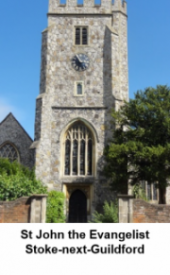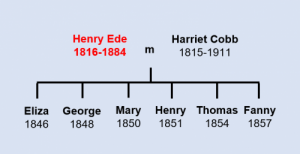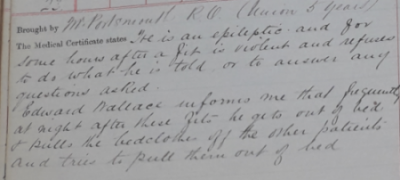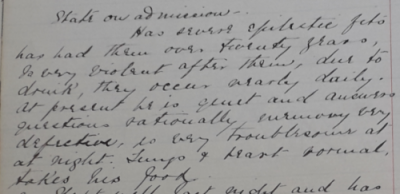HENRY EDE
Subject Name: Henry Ede (b1816 – d1884)
Researcher: Deborah Mandelli
Henry Ede was the first child of labourer George Eades and his wife Henrietta, his baptism in December 1816 taking place at St Peter’s Church, Woking (1, 2). They were at that time living in Pilehill (Pyle Hill) some two miles south of Woking. Henry’s sister, Rebecca, was baptised in the same church in 1821 (3). The spelling of the family surname varied, but Henry’s surname was mostly recorded as Ede in official records.
The family did not remain in Pyle Hill, as Henry’s siblings George, Harriet, Eliza and Caroline were baptised between 1823 and 1830 at St John’s The Evangelist Church, Stoke, then a village neighbouring Guildford (4, 5, 6, 7).
It was at Stoke parish church on 16 November 1844 that Henry Edes married Harriet Cobb, from  West Dean, Sussex (8, 9). Harriet’s father, like Henry’s, was a labourer. At the time of their marriage, they were living on Joseph’s Lane, Stoke, now known as Joseph’s Road (10). The marriage entry shows that neither Henry or Harriet could read or write as they both marked their names with an ‘X’, which probably accounts for the variations in spelling recorded by officials.
West Dean, Sussex (8, 9). Harriet’s father, like Henry’s, was a labourer. At the time of their marriage, they were living on Joseph’s Lane, Stoke, now known as Joseph’s Road (10). The marriage entry shows that neither Henry or Harriet could read or write as they both marked their names with an ‘X’, which probably accounts for the variations in spelling recorded by officials.
Henry had followed in the footsteps of his father George, working as an agricultural labourer to support his family, which by 1851, had expanded to include three children, Eliza (age 5), George (3) and Mary (1), at their home in Chertsey St, Stoke (9). The household included a visitor, George Cobb, Harriet’s younger brother (11).
Henry’s family remained in Stoke, and by 1861, the number of children had grown to six. The census of this year showed that Henry was working as a labourer in a flour mill, by now age 45, and the family had moved to a house on Stoke Road (12). The surname was recorded by the enumerator as Edes. Also at home were 13-year-old George who was working as an errand boy, Mary (11), Henry (9), Thomas (6), and Fanny (4). Mary, Henry and Fanny were all scholars. Thomas was not listed as a scholar, but was noted as ‘nearly blind’. Henry’s oldest child, Eliza, age 15, had left home and was employed as a domestic servant for a ‘sheriff’s officer’ nearby (13).
census of this year showed that Henry was working as a labourer in a flour mill, by now age 45, and the family had moved to a house on Stoke Road (12). The surname was recorded by the enumerator as Edes. Also at home were 13-year-old George who was working as an errand boy, Mary (11), Henry (9), Thomas (6), and Fanny (4). Mary, Henry and Fanny were all scholars. Thomas was not listed as a scholar, but was noted as ‘nearly blind’. Henry’s oldest child, Eliza, age 15, had left home and was employed as a domestic servant for a ‘sheriff’s officer’ nearby (13).
Still living on Stoke Road with Harriet and his family in 1871, Henry was now engaged as a corn porter (14). Also at home were his children George (23) a cordwainer (shoemaker), Mary (21) a dressmaker, Henry (19) an unemployed chemist’s porter, and Thomas (17) a newsagent’s messenger. There was no mention on this census of Thomas being blind, so maybe his sight had been improved with glasses, or the previous census was wrong. Fanny, age 14, had moved out to work as a domestic servant for a farmer/miller living at a corn mill in Stoke Next Guildford (15).
However, the census of 1881 showed Henry no longer living at the family home but as an ‘inmate’ at Guildford Union Workhouse (16), while his wife Harriet (63) and son Henry (27, a porter) remained in the family home on Stoke Road (17).
Henry senior was transferred from the workhouse a year later on 23 September 1882, at the age of 66, to Brookwood Mental Asylum (18).
On his admission to Brookwood, Henry’s ‘form of mental disorder’ was noted as ‘epilepsy’. He had been ‘insane’ and at the Union Workhouse for five years. The cause of Henry’s insanity was noted as ‘Drink’. His next of kin was his wife Harriet, of ‘nr the Hospital, Stoke Rd, Guildford’.
Described as being dangerous to others, but not suicidal, his Medical Certificate told how, in the  Workhouse, Henry had been generally ‘violent for some hours’ following an epilepsy attack, refusing to comply with requests or answer any questions. After these attacks Henry frequently at night ‘gets out of bed and pulls the bedclothes off the other patients and tries to pull them out of bed’.
Workhouse, Henry had been generally ‘violent for some hours’ following an epilepsy attack, refusing to comply with requests or answer any questions. After these attacks Henry frequently at night ‘gets out of bed and pulls the bedclothes off the other patients and tries to pull them out of bed’.
Further admission notes advised that Henry had suffered from epilepsy for 20 years, ie from around 1862. He became ‘very violent’ after the fits, which occurred ‘nearly daily’, so his family must have had a very tough time and been unable to cope with the violence prior to his admittance to the workhouse in about 1877.
 Little was understood about epilepsy at that time and how to treat it (19). On 28th September, five days after Henry’s admission, records state that the staff had noticed ‘symptoms of his fits coming on’ and ‘ordered a purge’, that is an emetic or laxative thought to clear ‘impurities’ from the body (20). Further entries mentioned several more epileptic episodes, but that Henry was no longer violent after them.
Little was understood about epilepsy at that time and how to treat it (19). On 28th September, five days after Henry’s admission, records state that the staff had noticed ‘symptoms of his fits coming on’ and ‘ordered a purge’, that is an emetic or laxative thought to clear ‘impurities’ from the body (20). Further entries mentioned several more epileptic episodes, but that Henry was no longer violent after them.
Sadly, over time Henry’s health worsened. By July 1883 his epileptic attacks had become much more severe and he was ‘getting more demented’. A year later, in July 1884, Henry’s health was ‘failing’, he was having ‘very severe’ attacks, and was ‘able to do very little work’.
Two months later, Henry took a further turn for the worse, and passed away on 7 September 1884, age 68. The Coroner gave the cause of death as ‘disease of brain with epilepsy’, and ‘heart disease’.
Henry’s wife, Harriet, outlived him by many years. In 1891, age 75 she was living ‘on her own means’ at 183 Fullers Rd, Croydon with her widowed daughter, Mary Upton (40), a ‘plain needlewoman shirt’ (21). By 1901 Harriet, now 85, had moved to 1 Nettles Terrace, Guildford, to live with her son George, 53, a grocer and beer retailer ‘on his own account’ (22). Harriet died in early 1911 in Guildford at the grand old age of 95 (23).
July 2022
Sources
Ancestry.co.uk
Epilepsy Society Epilepsysociety.org.uk
FindMyPast.co.uk / British Newspaper Archives
Government Register Office GRO.gov.uk
Surrey History Centre Surreycc.gov.uk/culture-and-leisure/history-centre
Victoria & Albert Museum vam.ac.uk
